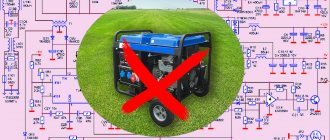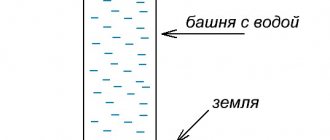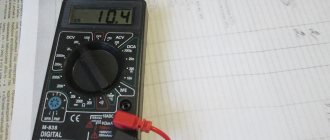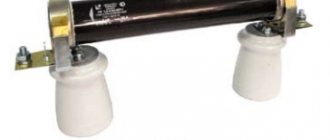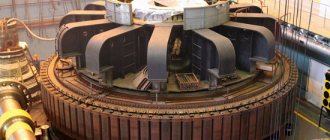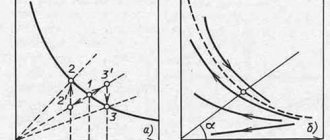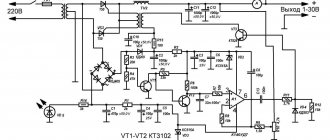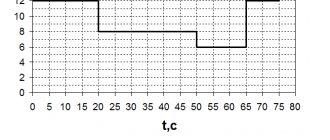Power sources for welding are various power frequency current converters or generators that independently generate electricity of the required parameters.
Due to the fact that electric arc welding requires special parameters of the supply current and voltage (to give an average example - the voltage is low and the current is very high), the standard voltage of a household or industrial network must be, at a minimum, reduced.
As a maximum, bring the operating characteristics of the power supply in line with the specified need. Therefore, special requirements are put forward for welding arc power sources.
Primary requirements
The power source for welding work of any type and class must satisfy the following key characteristics:
- ensure ease of arc ignition;
- maintain stable combustion;
- control the upper threshold of short circuit current;
- have good dynamics;
- comply with electrical safety requirements.
In this case, dynamics is understood as the speed of voltage recovery from the moment the electrode contacts the ground (the occurrence of a short circuit) until the arc flashes, that is, the formation of an electrical breakdown of the air.
The arc flashes at a voltage of about 20 V. The time from the moment of a short circuit to the arc flash with a good power source should be no more than 0.05 seconds. The smaller it is, the higher the dynamics.
In addition, it is very important that the source maintains a stable arc , that is, it automatically regulates the voltage change from no-load mode (60-90 V) to operating voltage (18-20 V).
These requirements apply to all devices without exception. Even a homemade welding machine assembled for manual arc welding from a computer power supply must comply with them.
By the way, using the latter to assemble a device for home use is not so difficult. The switching power supply is precisely designed to reduce the mains voltage. But only thin metal can be welded.
UPS Specifications
The key parameters of uninterruptible power supplies are:
- Output power (unit of measurement - VA or W) is the main criterion and reflects the maximum permissible load. When choosing a UPS for a refrigerator, submersible pump or other equipment with a powerful electric motor and significant starting currents, it is important to take into account that the power consumption when starting such a motor is 5–7 times higher than the rated value.
- Switching time, in ms – milliseconds during which the UPS switches to battery power. This UPS parameter determines its inertia and can reach 2–15 ms.
- Battery life, in min. – determined by the capacity of the battery and the power of the equipment being serviced. It is selected depending on the purpose of the UPS, in particular, for office use it is usually selected from 4 to 45 minutes. To have time to save information on a PC, a model designed for 5–10 minutes of operation is sufficient. If you need to ensure continuous operation of equipment using a battery, this parameter should be at least 20–30 minutes.
- Output voltage, in V.
- Form Uout. The voltage supplied to the load can be in the form of a pure sinusoid (for models of the On-Line class and partially for devices of the Line-Interactive category), an approximated sinusoid (with PWM) and a meander.
- The width of the Uin range within which the UPS stabilizes the power without switching to the battery. May depend on load. The wider this range, the longer the battery will last.
- Frequency Uin, in Hz – permissible range of network frequency fluctuations. Typically a deviation of ±1 Hz is acceptable.
- The coefficient of deviation of the Uout graph from the sinusoid, in %.
- Crest factor - the ratio of the maximum and average value of current consumption, is determined by the shape of Uin.
- The presence of a cold start function - it involves turning on the UPS in the absence of mains voltage.
- Permissible load, in% of rated power - reflects the resistance of the UPS to watt overloads.
- The battery life, in years, depends on the type of batteries used and the conditions of their use.
Principles of classification
Welding arc power sources are classified into many gradations. Among them:
- by purpose - for manual welding, submerged arc welding or shielding gas welding (for example, argon arc);
- by the number of welding stations that can be connected at a time;
- according to the ability to move - mobile and stationary;
- according to the method of energy production - converters or producers;
- by type of output current;
- according to the current-voltage characteristic (volt-ampere characteristic).
The main parameters of a welding machine for a welder are the purpose of this particular unit and the welding current that it produces. In many cases, the key requirement is the selection of the desired current-voltage characteristic (volt-ampere characteristic).
For example, for welding in a shielding gas environment, devices with a rigid characteristic that cook with direct current are required. For manual and semi-automatic submerged arc welding, alternating and direct current devices with a decreasing characteristic are used.
Some modern welding arc power sources are universal: they have many operating modes, including the ability to change the type of welding current and change its current-voltage characteristic.
Four types of converters
The main difference between welding arc power sources, which determines their technical characteristics, weight, dimensions and scope of application, is the difference in the principle of electric current conversion.
The following types of sources exist:
- transformers;
- rectifiers;
- converters;
- inverters.
Generators, the so-called units, stand apart. These machines are not secondary, but primary sources of energy; they do not convert power from a city or industrial network in one way or another, but generate it themselves.
As a rule, units are built on the basis of an internal combustion engine - gasoline or diesel. The former are cheaper, the latter have greater power and service life.
Classification of welding types according to physical characteristics
The classification of welding processes according to physical characteristics, although not directly related to the topic of the article, is indirectly related to power sources. Because it is thanks to them that it is possible to perform one or another type of welding.
There are three types of welding based on physical characteristics:
- Thermal
- Thermomechanical
- Mechanical
In thermal welding, the power source must generate an arc that will melt the metal using only its thermal energy. Arc welding, plasma-, electron-, ion-beam welding, electroslag, induction, gas welding - all these are thermal types of welding.
Thermo-mechanical welding involves not only the use of thermal energy, but also the application of pressure. These parameters are necessary, for example, for resistance welding. And also for diffusion, arc, slag, induction-press and furnace welding.
The classification of welding processes is complete without mechanical types of metal welding. With this type of welding, parts are joined under pressure and mechanical energy. These are explosion welding, cold welding, friction welding, etc. This type of welding does not use a welding arc and does not require a power source.
Transformer
This is the simplest type of welding machine. It is based on a choke - a reactive inductor.
A simple step-down transformer lowers the network voltage to the no-load value - 60...80 V. Subsequently, during operation, the welding voltage is maintained at 20 V.
The transformer operates only with alternating current. Its advantage is its simplicity of design (you can make it yourself by calculating the number of turns of both windings).
It has high efficiency, relatively low energy consumption, and is distinguished by reliability combined with maintainability. The transformer arc power source operates silently and costs relatively little.
But using alternating current for welding also has certain disadvantages. This welding arc power source has large dimensions and a very large mass.
The arc burns unstably and is highly dependent on surges in the supply voltage. There is a need to use special coated electrodes. The list of metals and alloys that can be welded with alternating current (mainly low-carbon steels) is limited.
Compared to backup generator sets, UPSs have a number of undeniable advantages
- significantly higher reliability coefficient;
- long time between failures;
- high quality of output electricity;
- no need for periodic maintenance and replacement of consumables;
- quiet operation;
- ease of connection and installation.
However, in order to ensure a relatively long autonomy time (from several tens of minutes to several hours), the UPS must be equipped with a sufficient number of rechargeable batteries (hereinafter referred to as batteries) of a certain capacity, which will most often be limited by the technical capabilities of the UPS, namely the capabilities of the battery charger. In addition, the battery life will depend on several other parameters: the degree of load of the UPS, the efficiency of a particular inverter, the ambient temperature, the condition and degree of wear of the battery.
Of course, it is possible to create a powerful uninterruptible power supply system with a long autonomy. But this raises the question of the economic feasibility of such a decision, and this is an important factor in the process of choosing an autonomous power source.
Currently, there are a lot of different types of generator sets on the Russian market, a wide range of capacities from many manufacturers, the various options of which will make even a sophisticated buyer think.
Below we provide a classification based on the main design features of generator sets. And we will give brief explanations, so to speak, at the everyday level, for each of the classification points.
Rectifier
For this purpose, semiconductor elements based on selenium or silicon are used. Rectifiers can be single-phase and three-phase, stationary or mobile, and have any current-voltage characteristic - either rigidly specified by the manufacturer, or changed by the user according to his needs.
Straighteners have many advantages. This is silent operation, high efficiency (higher than that of transformers), a wide range of uses (you can weld any metals and alloys). Such a power source has low no-load losses, relatively small dimensions and weight, and low energy consumption.
They have few disadvantages, but, unfortunately, they are quite significant. Rectifiers, as power sources for the welding arc, get very hot during the working process, so they need a good cooling system, which must be carefully monitored.
In addition, they are very sensitive to power surges, do not like dust, which can damage the cooling system, and are quite expensive.
Converters
A converter is a device that mechanically converts alternating current into direct current. Essentially, it is an electric motor that rotates the shaft of a DC generator. Once upon a time, these were the first devices capable of welding with direct current.
Generators powered by a gasoline or diesel engine operate on a similar principle.
Despite the seemingly illogical design, converters also have their pros and cons. Their main advantage is that these devices are insensitive to voltage drops - the output current always has a stable characteristic.
In addition, they can produce a very high current - 300, 500, some models 1000 A. In some types of work, for example, when welding thick metal plates, this is important.
Their disadvantages are their large mass (up to 500 kg), as well as the need for regular maintenance due to the presence of parts rotating at high speed. The efficiency of the converters is low due to the energy spent on spinning up the motor shaft.
Tasks of uninterruptible power supplies
UPSs perform several functions:
- They provide stable and continuous power supply to the equipment connected to them - they guarantee its backup power in case of problems with the standard power supply, including short circuits. The length of time the UPS can maintain backup power depends on the load being consumed and the characteristics of its battery.
- Improves the quality of power supply. Maintains normal power supply parameters: voltage, frequency.
- They guarantee reliable power supply to electrical equipment that standard power supply networks cannot provide.
- Absorbs relatively small and short-term voltage surges.
- Protect equipment from overloads and short circuits.
- Filters supply voltage and reduces noise.
Such devices are widely used with computers, heating boiler control circuits and other equipment that requires a stable supply of electric current with specified characteristics. They are in demand in various industries, the medical field, in offices and home environments - wherever it is important to prevent unexpected shutdown of equipment during power outages.
